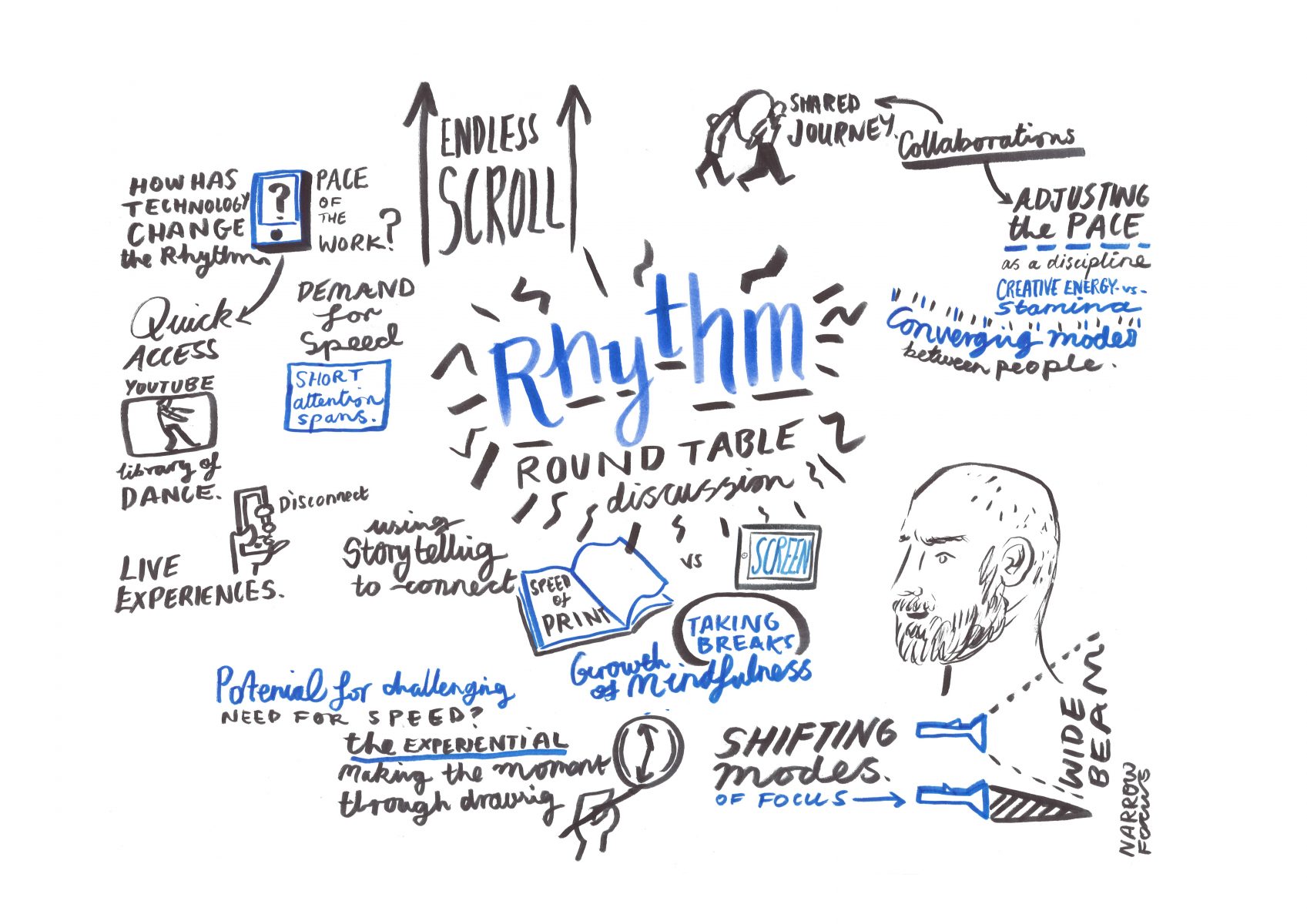Varoom 36 Roundtable – Rhythm

Image by Phoebe Halstead
Be-Bop-A-Lula, rhythm, and understanding how to work with it, is at the heart of all creativity. But new technology is rapidly changing the rhythms of image-making, of collaboration, and how we manage the rhythm of everyday life.
Matthias Sperling is a choreographer and performer, whose work has been presented at such institutions as Tate Modern, the Southbank Centre and the Royal Opera House. The first results of his two-year science research collaboration have just been published in the journal PLOS One.
Ryan Belmont is Art Director in the Nike Brand Design team, an internal in-house agency based in London. As Art Director he gets to work on experimental, collaborative communications highlighting Nike’s product innovation.
Phoebe Halstead is an animator at Scriberia, and a founder of First Hand a unique collective of collective reportage illustrators. Clients she has worked for include the Royal Institution, Channel 4, IBM, and The Times.
The Body in Motion
Ryan Belmont: … We have to see rhythm from a visual sense of course, but rhythm is so related to sport in a very simple way – it’s about movement. We are always trying to interpret the moving body; we actually use choreography to help us to do that sometimes. … Rhythm is intrinsic to the idea, but not at the forefront of our work as an objective. We talk about visualising ‘flexibility’, or ‘cushioning’ and ‘comfort’, these ideas start to pull you into places where the rhythm becomes different. There have been quite a few projects, such as the Hyperfeel shoe promotion, where they have used rhythm, not in the brief as such but in the end result.
Research and Perception
JO’R: This question applies to image-makers too, how do you process information from your body, the feedback, and to what extent are you aware or conscious of that?
MS: I think the unpredictable is really important and I would talk about that in terms of the relationship between something predictable – like the regularity of a rhythm – and the unpredictable in terms of variation that might diverge away from that. The relationship between those things is what produces dynamism
Interrupting the Rhythm
JO’R: You mentioned people’s capacity for attention now – over the last 20 years the internet, social media and smartphones have changed the rhythm of our everyday life. How has that affected you?
MS: I’m wondering about rhythm in the terms of pace and speed. We have been talking about engaging someone quickly, where because of attention spans, the speed of delivery is really high. I wonder about working with rhythm to challenge the constant acceleration of that demand for quick attention delivery? Is there a space for introducing a slower rhythm? Is disengagement the only option there? Is there a different kind of potential?
RB: Creating an “Off” moment? There’s the rise of Headspace, the meditation app, so many people are seeing the benefit of spending times with themselves. In the age of Mad Men, creatives had a lot of time for projects, the idea of a draughtsman now would just seem ludicrous.
Layers of Attention
PH: I like the image of those two different kinds of modes as a torch; so you can have the broad beam of the bigger view – everything is blurry, and then you can have the tight focus where you have that view of sorting out a tiny detail. The skill is knowing when it’s practical to shift between those two paces and focus.
The Personal and the Professional
JO’R: How do you shift between the two different modes and rhythms of the personal and the professional?
MS: It’s all part of the process. All the different layers of making something, from the conversations with the theatre or gallery, or conversations with people who give me funding support for the piece, the whole process is all of a piece in my mind. I would like to be as conscious as I can in that way. I think of the different relationships that the work gets made through. Each person I engage with contributes a lot to the process, how that unfolds, how people help me carry different stages of the process. People make contributions to the process all the way along.
RB: If you see a collaboration as a timeline, as a piece of music, you adjust your rhythm according to who you are working with at various points. Someone who is not a creative on the project but who still needs to understand, you will need to adjust yourself to that pace. You interact with them differently to someone on the creative team with whom you can be a bit quicker – you are bringing people along for the journey. In the commercial world everyone is selling their work and selling themselves, and how you do that is very personal, but it is really important knowing when to adjust – understanding when you are overcomplicating and when you need to simplify is a definite skill. I’m still learning that. It’s definitely important in my job, the adjustment of pace, the adjustment of rhythm.
Collaboration and the Client
PH: … There is nothing more frustrating when you have a perfect vision of something but the client’s vision is very different, and then you have to turn the work around and say, “Goodbye beautiful idea! That film could have been so great!” Ultimately, it’s for them.
Roundtable moderated by Varoom editor John O’Reilly
To read the full feature purchase Varoom 36 here
Back to News Page
